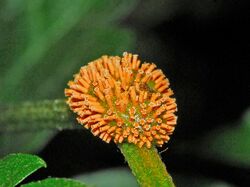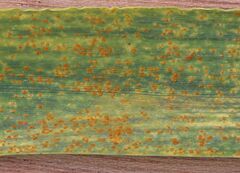Biology:Puccinia recondita
| Puccinia recondita | |
|---|---|

| |
| Puccinia recondita on Clematis vitalba | |
| Scientific classification | |
| Domain: | Eukaryota |
| Kingdom: | Fungi |
| Division: | Basidiomycota |
| Class: | Pucciniomycetes |
| Order: | Pucciniales |
| Family: | Pucciniaceae |
| Genus: | Puccinia |
| Species: | P. recondita
|
| Binomial name | |
| Puccinia recondita Roberge ex Desm. (1857)[1]
| |
| Synonyms | |
|
List
| |
Puccinia recondita is a fungus species and plant pathogen belonging to the order of Pucciniales and family Pucciniaceae.[41]
Distribution
This fungal species occurs worldwide.[42]
Biology
It is a heteroecious fungus, macrocyclic, and has five distinct life-stages of development: teliospores, basidiospores, and urediniospores on cereal hosts, and pycniospores and aeciospores on the alternative plant hosts.
Host
These fungi are endoparasites plant pathogens mainly infecting species in the families of Balsaminaceae, Boraginaceae, Hydrophyllaceae, Ranunculaceae and Poaceae (especially wheat and rye).[43] Puccinia recondita was also found to cause 'brown rust' in wheat and triticale (hybrid of wheat and rye). Symptoms of infestation are yellowish to brown spots and pustules on the leaf surfaces of the host plants.[44] Brown rust is the most widespread and prevalent disease of wheat in South America,[45] and is the most important wheat disease in Mexico.[46]
It was originally found on the leaves of a species of Secale (grass) in France.[47]
Subspecies and forms
- Puccinia recondita f.sp. secalis Miedaner, Klocke, Flath, Geiger & Weber 2012 - causes brown rust of rye.
In Iceland, Puccinia recondita ssp. borealis infects Agrostis canina, Anthoxanthum odoratum, Calamagrostis stricta, Hierochloe odorata and Thalictrum alpinum.[48]
Gallery
Puccinia recondita f.sp. tritici on Triticum aestivum
Puccinia recondita on Thalictrum flavum
See also
Bibliography
- George Baker Cummins: The Rust Fungi of Cereals, Grasses and Bamboos. Springer, Berlin 1971, ISBN 3-540-05336-0.
References
- ↑ Roberge ex Desm., Bull. Soc. bot. Fr. 4: 798 (1857)
- ↑ Erikss. & Henning (1895), In: Syll. fung. (Abellini) 11:204
- ↑ Pers. (1803), In: Icones Pictae Rariorum fungorum 4:58
- ↑ 4.0 4.1 Pers. (1796), In: Observ. mycol. (Lipsiae) 1:97
- ↑ Lamarck & de Candolle (1805), In: Fl. franç., Edn 3 (Paris) 2:243
- ↑ E. Fisch. (1904), In: Ured. der Schweiz:526
- ↑ Fr. Müll. (1901), In: Botanisches Centralblatt, Beihefte 10:201
- ↑ 8.0 8.1 Cooke (1871), In: Handb. Brit. Fungi 2:539
- ↑ de Candolle & Lamarck (1815), In: Fl. franç., Edn 3 (Paris) 6:97
- ↑ Cooke (1871), In: Handb. Brit. Fungi:540
- ↑ Grev. (1823), In: Scott. crypt. fl. (Edinburgh) 1:4
- ↑ Willdenow (1825), In: Willd., Sp. pl., Edn 4 6(2):48
- ↑ Kuntze (1898), In: Revis. gen. pl. (Leipzig) 3(2):467
- ↑ 14.0 14.1 Kuntze (1898), In: Revis. gen. pl. (Leipzig) 3(2):466
- ↑ 15.0 15.1 Kuntze (1898), In: Revis. gen. pl. (Leipzig) 3(2):468
- ↑ 16.0 16.1 Kuntze (1898), In: Revis. gen. pl. (Leipzig) 3(2):470
- ↑ 17.0 17.1 17.2 17.3 17.4 17.5 H. |Sydow (1921), In: Annls mycol. 19(1/2):171
- ↑ Ellis & Everh. (1892), In: J. Mycol. 7(2):131
- ↑ Erikss. (1899), In: Annls Sci. Nat., Bot., sér. 8 9:273
- ↑ 20.0 20.1 20.2 CABI Database
- ↑ Juel (1894), In: J. Bot., Lond. 51:411
- ↑ Urban, Z.; Marková, J. (1999) The rust fungi of grasses in Europe. 8. Puccinia bromina Eriks., In: Acta Univ. Carol., Biol. 43(2):119–134
- ↑ Gäum. & Terrier (1947), In: Ber. schweiz. bot. Ges. 57:244
- ↑ Erikss. & Henning (1894), In: Z. PflKrankh. PflPath. PflSchutz 4:175
- ↑ Erikss. & Henning (1894), In: Bull. Inst. bot. Univ. Belgrade 12:315
- ↑ Plowr. (1885), In: Quart. J. Microscop. Sci. 25:164
- ↑ Z. Urb. (1967), In: Ceská Mykol. 21:16
- ↑ 28.0 28.1 28.2 28.3 Marková, J.; Urban, Z. (1998) The rust fungi of grasses in Europe. 6. Puccinia persistens Plow., P. perplexans Plow., and P. elymi Westend., In: Acta Univ. Carol., Biol. 41(4):329–402
- ↑ Marková (1977), In: Boln Soc. argent. Bot. 18(1–2):180
- ↑ Urb.{?} & J. Marková (1977), In: Boln Soc. argent. Bot. 18(1–2):179
- ↑ Plowr. (1889), In: Monograph Ured. & Ustil.:180
- ↑ 32.0 32.1 32.2 D.M. Hend. (1961), In: Notes R. bot. Gdn Edinb. 23:504
- ↑ G. Winter (1881), In: Rabenh. Krypt.-Fl., Edn 2 (Leipzig) 1(1):217
- ↑ Mains (1933), In: Pap. Mich. Acad. Sci. 17:381
- ↑ Mains (1933), In: Pap. Mich. Acad. Sci. 17:352
- ↑ sensu auct. p.p.; fide Checklist of Basidiomycota of Great Britain and Ireland (2005) . Species fungorum
- ↑ Erikss. (1899), In: Annls Sci. Nat., |Bot., sér. 8 9:270
- ↑ Orbigny (1849), In: Dict. Univ. Hist. Nat. 12:785 [19 of extr.]
- ↑ de Candolle & Lamarck (1815), In: Fl. franç., Edn 3 (Paris) 5/6:83
- ↑ Lév. (1847), In: Annls Sci. Nat., Bot., sér. 3 8:371
- ↑ Index fungorum
- ↑ "Puccinia recondita Roberge ex Desm." (in en). https://www.gbif.org/species/7778821.
- ↑ Plant Hosts of Puccinia recondita
- ↑ Peksa, Kintija; Bankina, Biruta (December 2019). "Characterization of Puccinia recondita, the causal agent of brown rust: a review". _Research for Rural Development 2019 _ annual 25th International scientific conference proceedings. doi:10.22616/rrd.25.2019.051. https://www.researchgate.net/publication/339997173_Characterization_of_puccinia_recondita_the_causal_agent_of_brown_rust_a_review.
- ↑ German, S.; Barcellos, A.; Chaves, M.; Kohli, M.; Campos, P.; Viedma, L. (2007). "The situation of common wheat rusts in the Southern Cone of America and perspectives for control.". Australian Journal of Agricultural Research 58 (6): 620–630..
- ↑ Roelfs, A.P.; Singh, R.P.; Saari, E.E. (1992). The wheat rusts. Concepts and methodology for the disease management.. Mexico: _CIMMYT_. ISBN 968-6127-47-X.
- ↑ "Species Fungorum - Names Record". https://www.speciesfungorum.org/Names/NamesRecord.asp?RecordID=145187.
- ↑ Helgi Hallgrímsson & Guðríður Gyða Eyjólfsdóttir (2004). Íslenskt sveppatal I - smásveppir [Checklist of Icelandic Fungi I - Microfungi. Fjölrit Náttúrufræðistofnunar. Náttúrufræðistofnun Íslands [Icelandic Institute of Natural History]. ISSN 1027-832X
External links
| Wikimedia Commons has media related to Puccinia recondita. |
Wikidata ☰ Q24268 entry
 |





